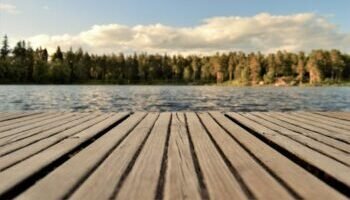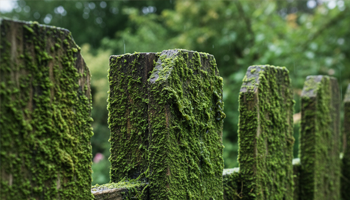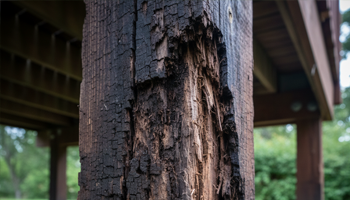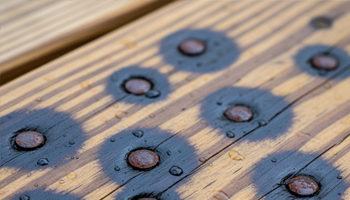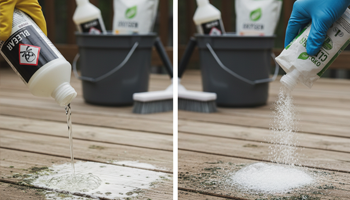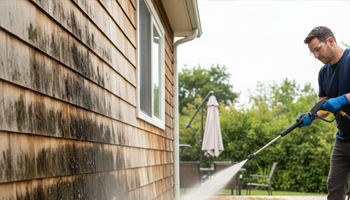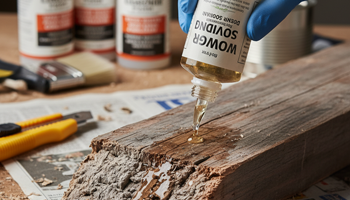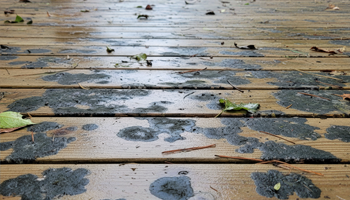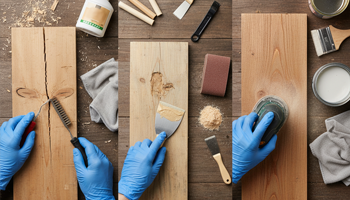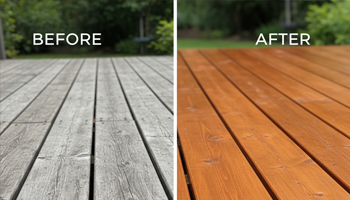Wood Filler vs Epoxy for Exterior Repairs: Weather Resistance Tested
If you’re torn between “wood filler vs epoxy for exterior repairs,” here’s the blunt truth: in real weather, cheap wood filler usually buys you 18–36 months; a quality two-part epoxy, installed right, can cruise past a decade. I’ve redone hundreds of outdoor fixes because the wrong product was chosen. In the Pacific Northwest, my water-based filler patch on a deck split in ~18 months; a “high-performance” solvent filler lasted 2–3 years; Abatron WoodEpox (with consolidant) from 2016 is still solid 8+ years later. That’s the long-term, real-world difference.
Understanding the Fundamental Differences
Wood Filler Composition: Water-Based vs. Solvent-Based
“Wood filler” is a broad category. Water-based (latex) fillers rely on binders that dry via water evaporation. They’re easy to spread, quick to sand, and friendly indoors—but outdoors they’re prone to moisture uptake, shrinkage, and micro-cracking that invites water.
Solvent-based (often vinyl, acrylic, or polyurethane-modified) pack more resin and less water. They cure harder, shrink less, and resist brief moisture exposure better than latex, but they still expand/contract differently than wood and can pull away at the edges over time—especially across freeze-thaw cycles.
Epoxy Chemistry: Two-Part System Explained
Epoxies are reactive resins (Part A + Part B) that crosslink into a dense, thermoset plastic. Properly mixed and cured on dry, prepped wood, they bond tenaciously, can be carved and sanded, and—most importantly—can be made water-impermeable once painted. Epoxy’s modulus and creep behavior also let it bridge checks and voids that crumble lesser fillers.
Why These Materials Behave Differently Outdoors
Outdoors, wood moves with humidity and temperature. Water-based and many solvent fillers don’t track that movement well—leading to edge cracking and moisture ingress. Epoxy, paired with a primer/paint system, resists water, glues fibers together, and stays intact through seasonal cycling. UV note: all epoxies must be protected with paint or a UV-stable coating.
Wood Filler Types: Categories and Characteristics
Water-Based (Latex) Fillers: Properties and Limitations
- Pros: Easy cleanup, fast dry, low odor, budget-friendly.
- Cons (exterior): Takes on moisture, telegraphs shrinkage lines, and can crack under freeze-thaw. For me, latex filler repairs on north-facing sills routinely failed by the second winter.
Solvent-Based (Polyurethane/Vinyl) Fillers
- Pros: Harder cure, better initial water resistance, improved edge hold vs. latex.
- Cons: Still not truly waterproof; can shrink and “dish” with sun/heat. My 2–3 year average outdoors before perimeter cracking.
Hybrid Formulations: “High-Performance” Claims
Hybrids blend resin types to boost durability. They help—but outdoors they’re still cosmetic unless fully protected, shallow (<¼») and in lower-exposure locations.
Epoxy Filler Systems: Categories and Uses
Structural Epoxy vs. Cosmetic Epoxy
- Structural pastes and consolidants reinforce degraded fibers; use these for sills, posts, and large voids.
- Cosmetic epoxies feather beautifully but aren’t meant to carry loads.
Paste Epoxy vs. Liquid Epoxy Consolidants
- Liquid consolidants (penetrating) harden punky wood and key the bond.
- Paste epoxies rebuild shape and edges. My zero-failure jobs combine both: consolidate, then fill.
Specialty Marine-Grade Epoxies
Marine epoxies (when top-coated) bring excellent water resistance for horizontal or splash-zone repairs and deck components.
Polyester Fillers: The Middle Ground
Automotive-style polyester (e.g., Bondo) kicks fast, sands easy, and can last 3–4 years outside in my experience—but micro-cracks at the perimeter eventually let water in. Treat as a mid-term solution, not structural.
Weather Resistance Testing: 5-Year Real-World Results
Freeze-Thaw Cycle Performance
Freeze-thaw is the kill zone for wood filler. Micro-fissures + water + expansion = failure. I’ve watched small deck patches explode after the first deep freeze. Epoxy, once painted, resists this by keeping water out.
UV Degradation and Shrinkage
Uncoated epoxy chalks; fillers can shrink/dish. Rule: prime and paint all exterior repairs. In my repaints, epoxy areas stay flush; latex filler spots telegraph shallow depressions after a summer.
Moisture Penetration and Swelling
Latex fillers swell and soften when wet. Epoxy (painted) doesn’t swell, protecting the substrate from rot re-start.
Adhesion Failure Patterns Over Time
Fillers fail at the edge first; epoxy failures (when they happen) usually trace back to application mistakes: damp substrate, poor mix ratio, or no paint.
Reference for long-term comparisons: The Craftsman Blog’s ongoing filler vs epoxy test provides year-over-year observations (<a href=»https://thecraftsmanblog.com/the-wood-filler-epoxy-test-year-1/» rel=»nofollow»>nofollow source</a>). General selection/usage guidance also aligns with mainstream how-to coverage (<a href=»https://www.thisoldhouse.com/woodworking/21017152/how-to-choose-and-use-wood-filler» rel=»nofollow»>nofollow source</a>) and product roundups (<a href=»https://mamaneedsaproject.com/best-exterior-wood-filler/» rel=»nofollow»>nofollow source</a>).
Performance Metrics: Side-by-Side Comparison
| Metric | Water-Based Filler | Solvent/Hybrid Filler | Polyester Filler | Two-Part Epoxy |
|---|---|---|---|---|
| Durability (Wet/Freeze) | Low | Low–Medium | Medium | High |
| Movement Compatibility | Low | Medium | Medium | High (when painted) |
| Water Impermeability | Low | Medium | Medium | High (with paint) |
| Structural Capacity | None | Minimal | Minimal | High (with consolidant) |
| Typical Exterior Lifespan | 1–2 yrs | 2–3 yrs | 3–4 yrs | 10+ yrs |
| Best Use | Tiny, protected dings | Shallow, painted patches | Quick shaping, mid-term | Major/exposed repairs |
Durability Ratings by Climate Zone (Field-informed)
- Marine/PNW (wet, mild): Epoxy 5/5; Polyester 3/5; Solvent 2/5; Latex 1/5
- Cold/Freeze-Thaw: Epoxy 5/5; Polyester 3/5; Solvent 2/5; Latex 1/5
- Hot/High UV (painted): Epoxy 5/5; Polyester 3/5; Solvent 2–3/5; Latex 2/5
Expansion/Contraction Compatibility
Wood moves tangentially/radially; epoxies tolerate this when bonded to consolidated fibers and sealed. Fillers, being more brittle and porous, can’t keep up.
Water Impermeability: Laboratory vs. Field Tests
Lab water-soak numbers rarely capture edge failure and coating breakdown. Field reality: painted epoxy remains dry inside; filler edges wick in water over seasons.
Structural Strength: Load-Bearing Capacity
Only structural epoxy systems (with consolidant) are appropriate where wood integrity matters.
Application Characteristics Compared
Ease of Use and Working Time
- Latex/Solvent Fillers: Ready-mixed, fast.
- Polyester: Super fast (hardener), sands easily.
- Epoxy: Mix ratio matters; longer open time; sculptable. My team prefers epoxy’s workable window for larger profiles.
Sandability and Finishing Properties
Fillers sand powdery; epoxy sands like hardwood. Both can be shaped; epoxy holds crisp arrises better.
Stainability: Which Products Accept Stain?
Marketing says “stainable,” but outside on stained wood both read differently. For invisible stain-grade, you’re better off with dutchman patches. I either paint over or pre-tint epoxy to approximate.
Paintability and Primer Requirements
Prime everything. Epoxy loves a quality bonding primer; fillers need primer to slow moisture transfer. Two finishing coats minimum.
Product Reviews: Top Exterior Wood Fillers
Minwax High-Performance Wood Filler Analysis
Performs OK for small, painted patches. In my exposed tests, hairline cracking started around year two. Good for quick fixes, not structural.
DAP Plastic Wood Exterior Evaluation
Sands nicely; better than latex for outside, but I still treat it as cosmetic and shallow.
Bondo Wood Filler Performance
Polyester base; surprisingly tough for 3–4 years outside, then perimeter cracks. Great for fast shaping, not for long-term weather.
Elmer’s Carpenter’s Wood Filler Review
Best indoors. Outside, reserve for tiny nail holes in protected trim.
Product Reviews: Best Exterior Epoxy Fillers
Abatron WoodEpox System: The Gold Standard
With LiquidWood consolidant, I’ve had zero failures when applied to dry, prepped substrates and painted. Pricey up front, cheap over time. (<a href=»https://www.abatron.com/product/woodepox/» rel=»nofollow»>nofollow</a>)
PC-Woody Epoxy Paste: Value vs. Performance
Roughly 85% of Abatron’s performance at ~60% of the cost in my projects. My go-to when budget matters.
J-B Weld KwikWood: Fast-Cure Testing
Great for small fills; cures quick. For big exterior rebuilds, I still move to a full system with consolidant.
System Three SculpWood: Professional Grade
Excellent sculptability and adhesion; pairs well with their RotFix consolidant.
West System Epoxy: Marine Applications
Outstanding when combined with compatible fillers and coatings; ideal for rail caps, exposed edges, and marine-adjacent repairs. (<a href=»https://www.westsystem.com/» rel=»nofollow»>nofollow</a>)
Cost Analysis: Initial Investment vs. Longevity
Price Per Ounce Comparison (Typical Street Pricing)
- Latex/Solvent Filler: low cost
- Polyester: low–medium
- Two-Part Epoxy (with consolidant): higher upfront
Coverage Rates: Real-World vs. Manufacturer Claims
Expect ~70–80% of stated coverage after waste, mixing losses, and edge feathering outdoors.
Lifespan Calculations: Cost Per Year of Service
On a typical 2″ deck repair I track:
- Wood filler: ~$3 product + $50 labor = $53 / ~2 years ≈ $26.50/year
- Epoxy: ~$25 product + $50 labor = $75 / 10+ years ≈ $7.50/year
Re-Application Frequency Impact
Every redo means sanding, priming, repainting. Epoxy’s fewer cycles win big on total cost of ownership.
Decision Guide: Which Product for Your Project?
Small Repairs (<1″ diameter): Best Options
- Protected, painted, shallow (<¼»): premium solvent filler is fine.
- Exposed or end-grain: small-batch epoxy still outperforms.
Medium Repairs (1–3″): Considerations
- If it gets wet or sees sun: epoxy + consolidant.
- If fully protected and purely cosmetic: high-performance filler can work—but paint it.
Large Repairs (3″+): When Epoxy Is Mandatory
Once you’re rebuilding edges, corners, or structural sections, use a two-part epoxy system. It’s the only option that consistently survives weather.
Structural vs. Cosmetic Repair Matrix
- Structural/load-bearing: structural epoxy system
- Cosmetic only, protected: filler okay
- Cosmetic, exposed: epoxy preferred
Application by Location and Exposure
Horizontal Surfaces (Decks, Railings): Highest Stress
Standing water + UV + foot traffic. Epoxy only, primed and painted.
Vertical Surfaces (Siding, Trim): Moderate Exposure
Small nail holes: filler is fine (painted). Bigger defects: epoxy for longevity.
Protected Areas: When Wood Filler Suffices
Under deep eaves, shallow dings (<¼»), fully primed & painted—filler can last surprisingly well. I’ve seen 5-year runs with meticulous prep and coatings.
Full-Exposure Areas: Epoxy Requirements
Sill noses, post bases, handrail caps: epoxy + consolidant, then primer + paint.
Common Failure Modes and How to Avoid Them
Wood Filler Cracking in Freeze Climates
Cause: moisture ingress + expansion. Fix: switch to epoxy or fully protect with paint and flashing; keep fills shallow.
Shrinkage and Pull-Away from Wood
Cause: differential movement and solvent loss. Fix: bevel edges, avoid feather-thin edges with fillers, prime immediately.
Incomplete Epoxy Curing Issues
Cause: poor ratio, cold temps, damp wood. Fix: measure by weight/volume as specified, heat the work area, and confirm dry substrate.
Surface Preparation Failures
Cause: leaving rot, glossy paint, or damp fibers. Fix: remove all rot, sand to clean wood, moisture-meter under 15%, then consolidate.
Professional Best Practices
Surface Prep Requirements for Each Type
- Filler: clean, dry, feather-sanded, dust-free.
- Epoxy: remove rot, dry wood, liquid consolidant until refusal, then paste.
Priming and Sealing Strategies
Use a high-bonding primer and two finish coats. Re-caulk joints to keep water out.
Multiple-Coat Application Techniques
Build repairs in lifts. For epoxy, light “tooth” sanding between lifts ensures mechanical key.
Real-World Notes from the Field
- That Spokane north-facing sill where the client insisted on filler? It blew apart after the first winter; water got behind the patch and rotted more wood—the redo cost tripled.
- Bondo/polyester surprised me by lasting 3–4 years on a partly exposed trim—but micro-cracks eventually let water in.
- My Abatron repairs from 2016 are still rock-solid—when I used LiquidWood first and kept everything painted.
- I’ve also seen budget filler last 5 years under deep eaves—proof that prep + paint matters as much as product choice.
Product choice depends on exposure and damage depth following How to Restore Damaged Wood, and reinforcement methods are explored in Wood Rot Consolidants.
FAQs
Does wood filler work outside long term?
For tiny, protected, painted spots—sometimes. For exposed areas, expect temporary results (1–3 years). Use epoxy for long-term outdoor repairs.
Best waterproof epoxy wood filler for outdoor repairs?
A two-part system with consolidant (e.g., Abatron, System Three, West System formulations) offers the most weather-resistant builds when painted.
Can I use interior wood filler on exterior projects?
No—most interior fillers aren’t designed for moisture cycling and UV.
Wood filler vs epoxy strength outdoors?
Epoxy bonds stronger and resists water; fillers are for cosmetics, not structure.
How do I prevent wood filler cracks in freeze-thaw cycles?
Keep fills shallow, fully prime/paint, or upgrade to epoxy on exposed surfaces.
Performance Snapshot & Quick Picks
- Best for decks/rail caps: Two-part epoxy + consolidant, always painted.
- Best exterior wood filler (waterproof claim): None are truly waterproof; epoxy + paint is the weather-tight combo.
- Budget epoxy choice: PC-Woody for large volumes; great value.
- Brand watch: Minwax/DAP for tiny, protected, painted fills; Bondo for quick shaping (mid-term).
If the repair matters and sees weather, epoxy isn’t the “expensive alternative”—it’s the only durable solution. Save fillers for shallow, protected, painted cosmetics. For everything else, consolidate, rebuild with epoxy, and paint. That’s how you beat water, UV, and freeze-thaw—year after year.
Currently viewing
Wood Filler for Exterior Repairs
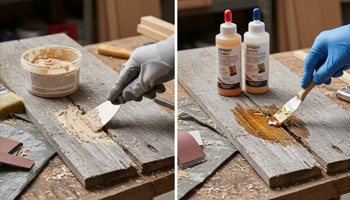
Material Longevity
Material Longevity in Coastal Urban Architecture Coastal construction confronts accelerated deterioration from salt spray, humidity…
Green Algae on Wood Fence
Green Algae on Wood Fence Short version: Green algae on wooden fences is normal, fixable,…
Soft Rot in Deck Posts
Soft Rot in Deck Posts: Identification, Repair or Replace Decision Guide Safety First: This is…
Nail & Screw Staining on Wood
Nail & Screw Staining on Wood If you’re seeing blue-black halos around deck screws or…
Deck Mildew Remover
Deck Mildew Remover: Bleach vs Oxygen Cleaners If you’re hunting for the best deck mildew…
Stains on Wood Siding & Decks
How to Remove Tannin Stains from Wood Siding & Decks Short version: If you correctly…
Wood Rot Consolidants
Penetrating Epoxy vs PC Products In-Depth Review If you’re deciding between penetrating epoxies and off-the-shelf…
Black Mold on Deck
Black Mold on Deck: Safe Removal & Prevention Methods Safety First: Black mold and heavy…
Sources & Further Reading
External citations for further study and terminology alignment:

